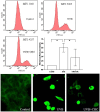Neuroprotection of a novel cyclopeptide C*HSDGIC* from the cyclization of PACAP (1-5) in cellular and rodent models of retinal ganglion cell apoptosis
- PMID: 25286089
- PMCID: PMC4186886
- DOI: 10.1371/journal.pone.0108090
Neuroprotection of a novel cyclopeptide C*HSDGIC* from the cyclization of PACAP (1-5) in cellular and rodent models of retinal ganglion cell apoptosis
Abstract
Purpose: To investigate the protective effects of a novel cyclopeptide C*HSDGIC* (CHC) from the cyclization of Pituitary adenylate cyclase-activating polypeptide (PACAP) (1-5) in cellular and rodent models of retinal ganglion cell apoptosis.
Methodology/principal findings: Double-labeling immunohistochemistry was used to detect the expression of Thy-1 and PACAP receptor type 1 in a retinal ganglion cell line RGC-5. The apoptosis of RGC-5 cells was induced by 0.02 J/cm(2) Ultraviolet B irradiation. MTT assay, flow cytometry, fluorescence microscopy were used to investigate the viability, the level of reactive oxygen species (ROS) and apoptosis of RGC-5 cells respectively. CHC attenuated apoptotic cell death induced by Ultraviolet B irradiation and inhibited the excessive generation of ROS. Moreover, CHC treatment resulted in decreased expression of Bax and concomitant increase of Bcl-2, as was revealed by western-blot analysis. The in vivo apoptosis of retinal ganglion cells was induced by injecting 50 mM N-methyl-D-aspartate (NMDA) (100 nmol in a 2 µL saline solution) intravitreally, and different dosages of CHC were administered. At day 7, rats in CHC+ NMDA-treated groups showed obvious aversion to light when compared to NMDA rats. Electroretinogram recordings revealed a marked decrease in the amplitudes of a-wave, b-wave, and photopic negative response due to NMDA damage. In retina receiving intravitreal NMDA and CHC co-treatment, these values were significantly increased. CHC treatment also resulted in less NMDA-induced cell loss and a decrease in the proportion of dUTP end-labeling-positive cells in ganglion cell line.
Conclusions: C*HSDGIC*, a novel cyclopeptide from PACAP (1-5) attenuates apoptosis in RGC-5 cells and inhibits NMDA-induced retinal neuronal death. The beneficial effects may occur via the mitochondria pathway. PACAP derivatives like CHC may serve as a promising candidate for neuroprotection in glaucoma.
Conflict of interest statement
Figures









Similar articles
-
Effects of cyclopeptide C*HSDGIC* from the cyclization of PACAP (1-5) on the proliferation and UVB-induced apoptosis of the retinal ganglion cell line RGC-5.Peptides. 2012 Aug;36(2):280-5. doi: 10.1016/j.peptides.2012.06.003. Epub 2012 Jun 15. Peptides. 2012. PMID: 22706041
-
PACAP Attenuates Optic Nerve Crush-Induced Retinal Ganglion Cell Apoptosis Via Activation of the CREB-Bcl-2 Pathway.J Mol Neurosci. 2019 Jul;68(3):475-484. doi: 10.1007/s12031-019-01309-9. Epub 2019 Apr 16. J Mol Neurosci. 2019. PMID: 30993644
-
Tetramethylpyrazine nitrone protects retinal ganglion cells against N-methyl-d-aspartate-induced excitotoxicity.J Neurochem. 2017 May;141(3):373-386. doi: 10.1111/jnc.13970. Epub 2017 Mar 3. J Neurochem. 2017. PMID: 28160291
-
Protective effects of pituitary adenylate cyclase-activating polypeptide (PACAP) against apoptosis.Curr Pharm Des. 2011;17(3):204-14. doi: 10.2174/138161211795049679. Curr Pharm Des. 2011. PMID: 21348830 Review.
-
Light-Induced Retinal Ganglion Cell Damage and the Relevant Mechanisms.Cell Mol Neurobiol. 2020 Nov;40(8):1243-1252. doi: 10.1007/s10571-020-00819-0. Epub 2020 Feb 27. Cell Mol Neurobiol. 2020. PMID: 32107750 Free PMC article. Review.
Cited by
-
Emerging Role of PACAP as a New Potential Therapeutic Target in Major Diabetes Complications.Int J Endocrinol. 2015;2015:160928. doi: 10.1155/2015/160928. Epub 2015 May 14. Int J Endocrinol. 2015. PMID: 26074958 Free PMC article. Review.
-
Glaucomagenesis following ionizing radiation exposure.Mutat Res Rev Mutat Res. 2019 Jan-Mar;779:36-44. doi: 10.1016/j.mrrev.2019.01.001. Epub 2019 Jan 8. Mutat Res Rev Mutat Res. 2019. PMID: 31097150 Free PMC article. Review.
-
PACAP Is Protective in a Rat Model of Retinopathy of Prematurity.J Mol Neurosci. 2016 Oct;60(2):179-85. doi: 10.1007/s12031-016-0797-5. Epub 2016 Aug 25. J Mol Neurosci. 2016. PMID: 27561927
-
Neuroprotective Peptides in Retinal Disease.J Clin Med. 2019 Aug 1;8(8):1146. doi: 10.3390/jcm8081146. J Clin Med. 2019. PMID: 31374938 Free PMC article. Review.
-
Inhibition of retinal ganglion cell apoptosis: regulation of mitochondrial function by PACAP.Neural Regen Res. 2018 May;13(5):923-929. doi: 10.4103/1673-5374.232489. Neural Regen Res. 2018. PMID: 29863024 Free PMC article.
References
-
- Nucci C, Strouthidis NG, Khaw PT (2013) Neuroprotection and other novel therapies for glaucoma. Curr Opin Pharmacol 13: 1–4. - PubMed
-
- Vaudry D, Gonzales BJ, Basille M, Yon L, Fournier A, et al. (2000) Pituitary adenylate cyclase activating polypeptide and its receptors: from structure to function. Pharmacol Rev 52: 269–324. - PubMed
-
- Vaudry D, Falluel-Morel A, Bourgault S, Basille M, Burel D, et al. (2009) Pituitary adenylate cyclase activating polypeptide and its receptors: 20 years after thediscovery. Pharmacol Rev 61: 283–357. - PubMed
Publication types
MeSH terms
Substances
LinkOut - more resources
Full Text Sources
Other Literature Sources
Research Materials
Miscellaneous

